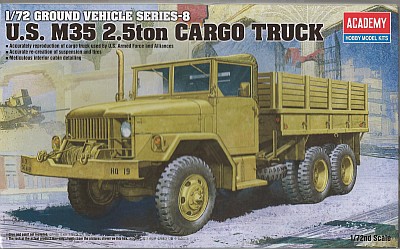|
Academy |
U.S. M34 2.5ton Cargo Truck |
|||
| Kit #: 13410 |
Preview by
Will Alcott
- will_alcott(at)yahoo(dot)com
Edited by Al Magnus |
|||
|
Academy |
U.S. M34 2.5ton Cargo Truck |
|||
| Kit #: 13410 |
Preview by
Will Alcott
- will_alcott(at)yahoo(dot)com
Edited by Al Magnus |
|||
 |
|
This was Academy's first post-WWII vehicle in their ‘Ground Vehicle Series’. The box art depicts a desert scheme M35A2. Inside, there are three sand-coloured sprues of well-moulded parts, a small decal sheet with options for two vehicles, and the instruction booklet. The first question that arises is, what version does this model actually depict? The kit is described as an M35. The M35 (no suffix) was the original, gasoline engined version of the series. It was soon replaced by the M35A1 and A2, which introduced diesel and multi-fuel engines respectively. The M35A3 was a rebuild of earlier A2 models, with a new engine, and modified grille and hood. The M35 and early production M35A1 featured a low mounted exhaust, exiting behind the right rear wheels. The most obvious distinguishing feature between the M35 and M35A1 was the mushroom shaped air intake on the right side of the engine cover, found only on the A1 and later models. Late production M35A1s and all subsequent models had a vertical exhaust stack mounted in front of the passenger side door. Most M35A2s featured later style marker lights/turn signals on the fenders and at the rear, while earlier models had traditional blackout driving lights in those locations. M35 and M35A1 rear lights were suspended from the underside of the cargo bed, while the M35A2 had them on horizontal extensions off the rear of the chassis. The box art vehicle looks like an M35A2, with the later model lights and vertical exhaust. Inside, the model features a mix of
features - the vertical exhaust stack of the A2 (and perhaps late A1), the early blackout lights on the fenders like the M35/M35A1 and the taillight configuration
of the A2. Strangest of all, the kit is missing the air intake on the engine cover. So the model could be best described as a gasoline engined M35, with an M35A2
exhaust, M35A1 front blackout lights and M35A2 rear lights. It's quite possible Academy may have referred to a rebuilt/restored vehicle with a mix of features. To
model a particular variant, you would need to:
The parts are very cleanly moulded, with good detail. The cab is moulded as a single piece through use of multiple part (slide?) moulds, and features excellent grille detail, though you may wish to drill out the moulded-in headlights and replace them with MV lenses. A handful of parts suffer from sink marks. Ejector pin marks are common, and are located in visible locations on the cargo bed parts. The cab interior consists of a one-piece floor and fenders with the seats and pedals moulded in, a steering column and wheel, and a dash board with instruments. No control levers are provided (there should be three). A canvas cover for the cab is provided. The folding windscreen features some very crisp detail, including tiny wing nuts. No clear plastic is provided for the windscreen or cab rear window. As previously noted, the air intake is missing from the side of the engine cover. Also, the blackout lights on the fenders are missing the brush guards (clearly shown on the box top painting). The chassis is well detailed, with a multi-part frame and drive line. A detailed winch is included for the front bumper. Comparing the parts with the box art, the towing eyes for the front bumper are missing. Ten wheels and the frame-mounted spare are provided. All are well moulded, though ejector pin marks mar the inside surfaces of all tires. The storage boxes below the cab are both moulded open at the bottom. The cargo bed features bench seating, and good detail on both sides of most of the parts. No bows or tarp for the cargo bed are provided. The small decal sheet provides markings for an olive drab truck in Vietnam and a sand truck in Iraq. Markings include serial numbers, bumper codes, some stencilling and white stars for the OD truck. Without building the kit, it's tough to estimate dimensional accuracy. I took a couple quick measurements of the parts, and found the wheelbase looks to be spot on, the width of the cargo bed is within 0.5 scale inches, while the length of the cargo bed is short by 7 scale inches. The tires look to be very close in diameter. I also compared the Academy kit to ARMO's beautiful resin kit. The most noticeable difference was in the length of the cab. The Academy cab is slightly longer, while the ARMO bed is longer. I suspect that overall, both are close to the correct length, with ARMO's dimensions being a touch more accurate. The holes in the wheels are another difference - Academy's are probably a little too small, and ARMO's a little too big. The details in the ARMO kit are finer, but the resin is more brittle and harder to work with. Overall, I'm really impressed with the Academy kit. The inaccuracies are very small and probably invisible to all but an expert eye. This is one of the nicest injection moulded soft skin kits I've seen, with excellent conversion potential. Highly recommended! |
| Back to Academy Kit List | Back to Home Page |
Article Last Updated: 28 January 2012 |